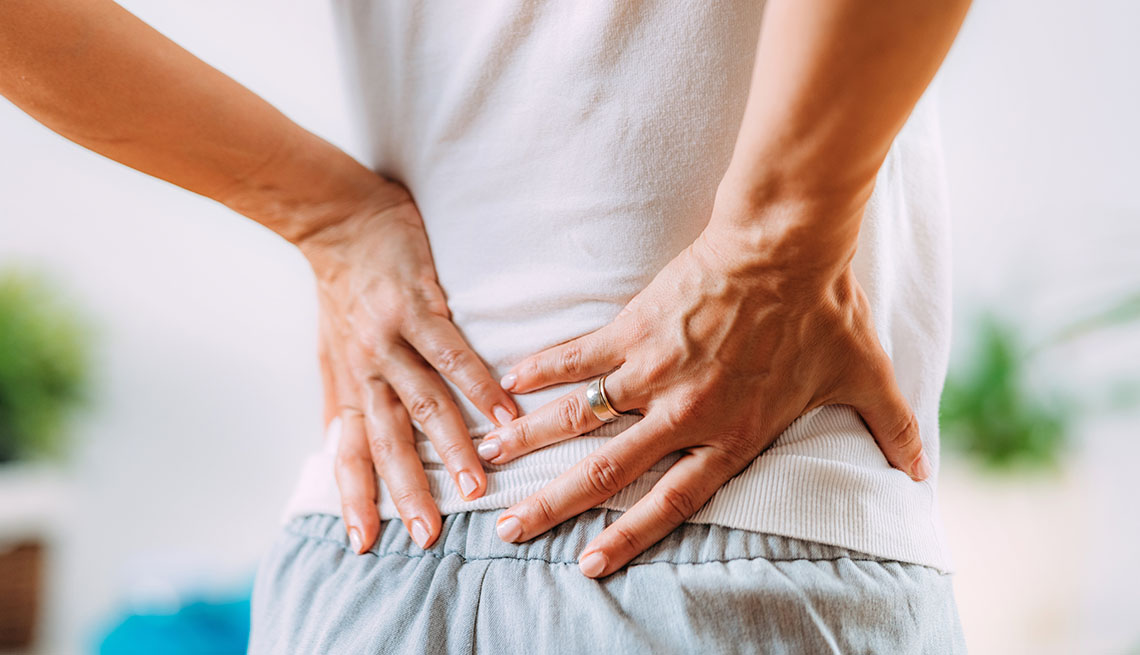
- Select a language for the TTS:
- UK English Female
- UK English Male
- US English Female
- US English Male
- Australian Female
- Australian Male
- Language selected: (auto detect) - EN
Play all audios:
HOW DO YOU RELIEVE BACK PAIN? _WALKING_ When lower back pain strikes, you don’t need to take it lying down. On the contrary, you should keep moving by walking regularly. “Walking is one of
the most therapeutic things you can do for your back,” Gillanders says. “Yet it’s low hanging fruit that’s not used that often.” Studies have found that walking improves pain levels,
disability and quality of life among people with chronic low back pain. _ICE OR HEAT_ To relieve low back pain fast — whether short-term or chronic — you can apply an ice pack or heat
(whichever you’d prefer) and use a foam roller to release tension, Gillanders recommends. _BREATHING_ It can help to engage in diaphragmatic breathing, says Alex Garreau, a physical
therapist at Northwestern Memorial Hospital in Chicago. As you inhale slowly, let your belly expand with air, then exhale slowly, allowing your belly to deflate. “This slows down your
breathing, which can slow down pain signals and have a calming effect,” Garreau explains. _BRACES AND OTHER TOOLS_ If you have sudden, sharp pains, a soft corset brace may help during
activity by acting as a crutch for muscles that aren’t ready for certain tasks. Just know that if you wear it too frequently, it can cause these muscles to “take a vacation” and contribute
to further pain and weakness, DeGeeter says. Save it for short-term use. “If a patient needs to get through a certain season of life — say for holiday prep, a wedding or work in the yard
during the spring,” a brace can be helpful, DeGeeter says. Other tools to relieve lower back pain include pillows, towel rolls and 2-inch stools. Placing pillows on your lap while sitting
can help take weight off the spine and improve its alignment. Feet don’t reach the floor when you sit? Dangling legs can pull on your spine and cause pain, but a small footstool (or even old
phone books) can remedy that, DeGeeter says. Lumbar rolls are popular. A 2019 study in the journal _Applied Ergonomics_ found an association between static sitting behavior and chronic low
back pain among people who worked at a call center. If you have a job or medical condition that involves sitting for long periods, consider using a lumbar roll, a soft cylindrical device you
put between your back and the chair. It helps support your lower back by promoting a semi-extended position that can alleviate discomfort and improve pain. WARNING SIGNS YOU SHOULDN’T
IGNORE Some red flags with lower back pain: If the pain radiates down one of your legs; if you have numbness, weakness or tingling in one (or both) of your legs; or if you experience changes
in your bowel or bladder function, call your doctor right away, advises Stacey Cladis, a physical therapist at Northwestern Medicine in Chicago. These symptoms could be caused by spinal
cord compression or nerve compression. If the pain persists for more than a week or prevents you from doing daily activities, it’s a good idea to see a doctor. TIPS FOR STARTING PHYSICAL
ACTIVITY Bise recommends adding a walking routine to complement the stretches listed below. Though step count is all well and good, it’s not the only thing that matters. Your walking speed
and the length of your strides bring health benefits, too, Bise says. Gradually increasing your walking speed and distance can enhance stamina and overall endurance. As you test out
exercises and stretches, pay attention to any pain that arises, knowing that some muscle soreness is to be expected. Make sure not to overdo it — start slow, and gradually increase your
activity. Questions? Reach out to a physical therapist. Many offer initial visits to get started on an at-home program. A study published in _JAMA_ found that people who received tailored
instruction from a physical therapist experienced greater and longer-lasting benefits compared with those who participated in a more generalized strength and flexibility exercise program.
“One-on-one treatment with a well-trained physical therapist will help you determine which exercises are best for your body type, as well as help you to troubleshoot the specific activities
in your life that are causing you pain,” DeGeeter says. Above all, stick to the program that works best for you. Once pain starts to improve, don’t stop or it will likely come back. Consider
these exercises as a long-term lifestyle change, rather than a temporary solution. 8 EXERCISES TO HELP WITH BACK PAIN A word of warning: As you do these exercises, be sure to listen to your
body and heed its messages. “If something is hurting, don’t do it,” Cladis says. “You can aggravate your symptoms if you’re trying to push through the pain.” If doing these exercises and
stretches on the floor is too difficult, you can try completing them on a bed. Shutterstock 1. STANDING LUMBAR EXTENSION In a standing position with your feet apart, place your hands on your
lower back with your fingers pointing down. Bend your body backward at the waist, supporting your trunk with your hands, and keep your knees straight. MODIFICATION: Perform the stretch with
your back against a countertop for support.






